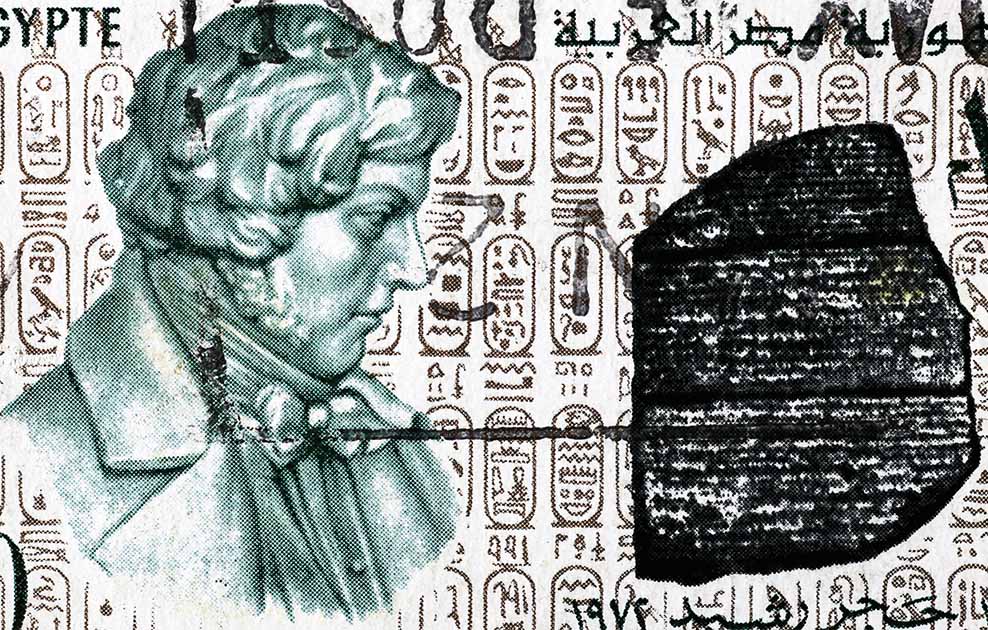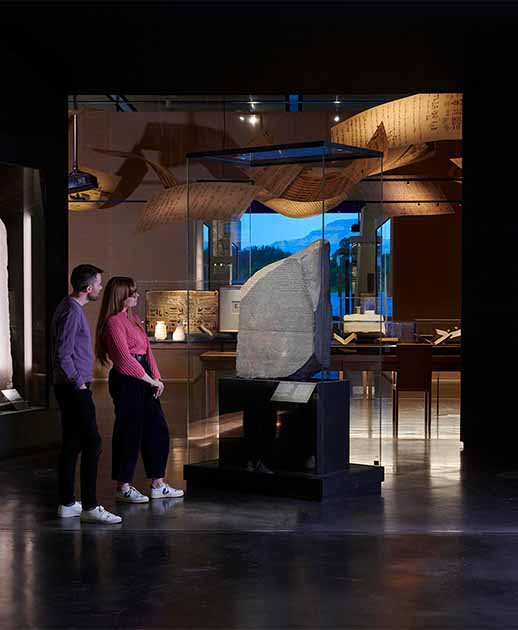
Remembered as the father of Egyptology, the 19th-century Frenchman Jean-François Champollion prematurely and tragically passed away in 1832 shortly after visiting Egypt. In 1822, Champollion deciphered the iconic Rosetta Stone, unlocking the enigmatic hieroglyphic texts texts discovered in ruins up and down the length of Egypt. In 2022, on the bicentennial of his remarkable achievement, France commemorated Champollion’s legacy through a series of events and celebrations.

Leon Cogniet’s portrait of Jean-François Champollion. ( Public domain )
The Life and Legacy of Jean-François Champollion
Born in 1790, in a French town known as Figeac which is now home to the Musée Champollion – Les Écritures du Monde (Champollion Museum – Writings of the World), Jean-François Champollion displayed an early passion for languages and ancient history. From a young age he demonstrated exceptional linguistic skills and a deep curiosity for deciphering ancient scripts.
Champollion’s groundbreaking achievements came to fruition in 1822 when he successfully deciphered the Rosetta Stone, unraveling the mysteries of Egyptian hieroglyphics . This work was made possible by his research and knowledge of languages, including Coptic and Demotic. Cracking the hieroglyphic code carved onto the Rosetta Stone opened up a new world of understanding, shedding light on the rich history, culture and civilization of ancient Egypt .
While the Rosetta Stone itself was discovered in Egypt in 1799 by French soldiers during Napoleon Bonaparte’s campaign, and the stone was transported to the British Museum in London in 1802 under the terms of the Treaty of Alexandria, it was Champollion who made the breakthrough in Paris, France, based on drawings and copies of its inscriptions. He did so after years of linguistic study, historical analysis and comparison of the Rosetta Stone’s inscriptions with other known ancient texts
After a lifetime dedicated this research of hieroglyphics, Jean-François Champollion embarked on his final trip to Egypt in 1828. The purpose of his visit was to further explore the ancient sites and gather additional knowledge about Egyptian civilization, while immersing himself in the rich cultural and historical tapestry that had captivated him for years. However, his health began to deteriorate during the expedition and upon returning to France his condition worsened. Tragically, he passed away in 1832, leaving behind an extraordinary legacy.

Detail from one of Jean-François Champollion’s notebooks. ( Public domain )
Seeking Answers: Investigating the Cause of Champollion’s Untimely Death
Jean-François Champollion’s premature death at the age of 41 has often been attributed to exhaustion caused by his year-long visit to Egypt. It was believed that the strain of deciphering the Rosetta Stone and the demands of exploration took a toll on his health and that he ultimately succumbed to a stroke. “I sleep two or three times a week with the Rosetta inscription,” he wrote in 1814, in a passage quoted by The Washington Post . “So far I’ve only gained headaches and two or three words.”
New medical research, however, has challenged this conventional explanation and suggests that other factors may have contributed to his decline. While the exact cause of his death remains uncertain, experts question whether a stroke alone was solely responsible.
Published in 2015, a letter to the editor of the journal Clinical Neurophysiology by Dr. Hutan Ashrafian of the Department of Surgery and Cancer, Imperial College-London, claimed that the term “stroke” was used in a generic sense rather than as a formal medical diagnosis. Lacking access to an autopsy, Ashrafian studied reports of Champollion’s condition over the years in order to reach certain conclusions about the death of the great scholar.
During his trip to Egypt, Champollion did not suffer from lymph disease or fevers. However, accounts of his final years shed light on a different set of afflictions. Although he did not show symptoms of heart disease or impaired blood flow, Champollion faced the daunting challenges of muscle weakness, limb paralysis, and ultimately, the inability to breathe.
“Furthermore, at the moment of decipherment of hieroglyphs (1828), he is noted to have collapsed, though this may be viewed as a vasovagal [fainting] episode as a result of extreme emotional outpouring,” wrote Ashrafian. “In his final weeks he became emotionally labile consistent with progression of pseudobulbar dysfunction, and eventually demonstrated a ‘locked-in’ syndrome before his death.”
Thus, according to this diagnosis, Jean-François Champollion, who gave voice to the ancient Egyptians through his decipherment of hieroglyphics , faced pseudobulbar dysfunction, an affliction which rendered him unable to speak. It may be considered ironic that a man who opened the ancient Egyptian world to modern scholarship was incapable of articulating his own thoughts just before he died.
After careful examination of Champollion’s symptoms, Dr. Ashrafian reached a compelling conclusion: the esteemed scholar had been grappling with amyotrophic lateral sclerosis (ALS), a debilitating condition causing progressive muscle paralysis. Notably, Champollion did not exhibit mental impairment or seizures, but rather experienced initial weakness in his legs, which later extended to a loss of speech. This diagnosis sheds new light on the challenges Champollion faced and further deepens our appreciation for his unwavering determination in deciphering the mysteries of ancient Egypt amidst his own physical decline.

The Rosetta Stone on display at the British Museum. ( British Museum / CC BY-NC-SA 4.0 )
Words of the Gods: The Rosetta Stone and the Legacy of Champollion’s Work
The term “hieroglyph” derives from the Greek words meaning “sacred words” or “sacred signs,” as first utilized by Clement of Alexandria. In ancient Egypt, their own script was referred to as mdju netjer or “words of the gods.” The earliest known hieroglyphs can be traced back to the pre-dynastic era, approximately from 3400 to 3200 BC. However, the last evidence of hieroglyphs in use can be found around 394 AD, marking the culmination of their historical prominence and significance in ancient Egypt.
Hieroglyphs abound on ancient Egyptian artifacts, carved into clay seals, rock, pottery vessels, bone, ivory and, as in the case of the Rosetta Stone stela, into basalt. “When Pharaonic Egypt became Christianized in the 4th century, the meaning of Egyptian hieroglyphics was lost for about 1,500 years,” explained The Washington Post . Rather than a kind of script, the symbols came to be understood as pagan pictograms instead. For Champollion, the Rosetta Stone was a pivotal artifact in unraveling the hieroglyphic code because of its inclusion of the same inscription in three scripts; hieroglyphs, Egyptian demotic and ancient Greek.
- Google Launches AI Cyber Rosetta Stone for Hieroglyphic Translations
- Egyptian Hieroglyphs: The Language of the Gods
While Jean-François Champollion’s translation was a milestone for Egyptology, the field has continued to advance, leading to evolving linguistic understanding, new insights and revisions in translations over time. The inscription itself was crafted by Egyptian clergy to commemorate the first anniversary of Ptolemy V ’s coronation in 196 BC. The so-called Rosetta Stone served as a powerful affirmation of the royal cult dedicated to the young Pharaoh, and the inscription explicitly dictated that the stone was to be reproduced and distributed across the temples throughout Egypt.

Statue of Jean-François Champollion by Frédéric-Auguste Bartholdi. (Rama / CC BY-SA 3.0 FR )
France’s Bicentennial Celebration of Champollion’s Groundbreaking Discovery
To celebrate the bicentennial of Champollion’s discovery, France presented a series of spectacular events in 2022. After three-year-long preparations, the Bibliothèque Nationale de France (BNF), or the “French National Library,” put together an exhibition of about 350 artifacts. These were displayed alongside a curated selection of Champollion’s unpublished documents, based on 88 volumes of notes and illustrations he left behind which are currently stored at the BNF.
Titled L’Aventure Champollion: Dans le secret des hieroglyphs , or “The Champollion Adventure: Within the Secret of Hieroglyphs,” the exhibition aimed to vividly portray Champollion’s renowned work by showcasing the meticulous research methods he employed. The goal was to bring his extraordinary journey to life, offering visitors an immersive experience into the world of hieroglyphs.
Jean-François Champollion’s birthplace in Figeac also hosted a six-month series of events to celebrate his legacy. Dubbed Eurêka! Champollion 2022 , activities included concerts, movie screenings, theatrical performances, museum exhibitions and seminars led by prominent Egyptologists. Since 1995, the town square of Figeac has been home to a magnificent black granite replica of the Rosetta Stone crafted by the American conceptual artist Joseph Kosuth.

The monumental reproduction of the Rosetta stone by the American conceptual artist Joseph Kosuth in Figeac, Jean-François Champollion’s birthplace, known as the Place des Écritures. (Bmclaughlin9 / CC BY-SA 3.0 )
Meanwhile, the Louvre-Lens Museum hosted the captivating exhibition Champollion: The Path of Hieroglyphs up until January 2023, offering a profound exploration of Champollion’s groundbreaking discovery and unveiling his personal journey.
One aspect revealed by the exhibit is that despite his humble origins in southwestern France, Champollion’s association with Joseph Fourier, a scholar who accompanied Napoleon on his Egyptian expedition , provided him an opportunity to pursue studies in Paris. The city’s deep fascination with ancient Egypt was evident through its abundance of Egyptian artifacts, which aided Champollion in his work, and the exhibition meticulously presented the resources available during his time in Paris.
The exhibit featured the renowned statue of Champollion sculpted by Frédéric-Auguste Bartholdi, the mastermind behind the Statue of Liberty in New York City. Since 1878, this statue has graced the main courtyard of the Collège de France in Paris. For this was the city where Champollion was appointed by King Charles X to oversee the newly acquired Egyptian collections at the Louvre, in recognition of his remarkable achievements deciphering the hieroglyphs of the Rosetta Stone .